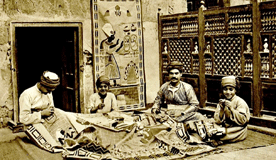Khayameya
About Khayameya
Kheyma means "tent" in Arabic and Khayameya is the ancient craft of making huge tent pavilions, out of appliquéd cloth patterns carried on for hundreds of years. All of the designs used in the making of a new tent must first be drawn on large sheets of brown paper. A fine needle point pricks out the outline of each pattern in tens of thousands of small holes. The perforated sheet of paper is then laid upon each chosen piece of colored cloth - brilliant blue, blazing red or scintillating green. A black carbon dust is sprinkled lightly over the paper so that the dust percolates through the holes, leaving behind a fine stencil outline of the pattern pounced onto the cloth, ready to be cut out. Khayameya website is providing incredible collection of handmade cushion covers, tablecloths (Linens), table runners, bed runners, and much more.

About Khayameya
Egyptian Tentmaking
Khayameya (Egyptian Arabic خيّامية Khayyāmeyah) is a type of decorative appliqué textile historically used to decorate tents across the Middle East. They are now primarily made in Cairo, Egypt, along a covered market known as the Street of the Tentmakers (Share'a el Khayamiya, or Souq El-Khaymeya). This street is located immediately south of Bab Zuweila, and has been in continuous use since the Mamluk era.
Khayameya are elaborately patterned and colourful appliques applied to the interior of tents, serving a dual function of shelter and ornament. They resemble quilts, and possess the three layers typical of quilts - a heavy 'back', a background 'top', and elaborate applique over the 'top'. Functionally, they can be compared to curtains, though their recent roles have diversified to cater for touristic purposes. These now include cushion covers, tablecloths, bed and tables runners.

Khayameya Design
Khayamiya feature hand-stitched cotton appliqué over a heavy cotton back. This back is intended to be protective and durable against a hot, dry, and dusty climate. The hand-stitching is performed quickly by skilled tentmakers while seated cross-legged, using needles and thread. Small pieces of fabric are cut to size as they are required using large scissors. Khayamiya are usually completed by a single tentmaker regardless of the size of the piece. These can range from basic cushion covers to intricate whole-wall hangings several metres across. Large projects can subsequently take several months to complete. The tentmakers are very protective of their creative innovations, as successful new designs are often copied by their competitive neighbours.
Popular design motifs include geometric and curvilinear arabesque patterns derived from Islamic ornaments, and scenes inspired by Pharaonic art, especially papyrus and lotus motifs. Egyptian folkloric subjects such as Goha, Nubian musicians, and the whirling dervishes are popular touristic souvenirs, as are stylised depictions of fish and birds. Calligraphic patterns, based upon texts from the Qur’an, are often shaped into objects and animals. Examples made in the early twentieth century feature larger blocks of appliqué and wider stitching, though khayamiya made since the 1990s have favoured finer and more elaborate handwork.

Historic Khayameya
Historic specimens of khayamiya are rare. They were originally made to be placed outside in dry heat and dust, and were regarded as replaceable - hence not highly valued for collection or preservation. Four older examples are held in the collection of the British Museum. There are also references to Khayamiya in photographic records and European orientalist paintings from the nineteenth century and earlier. Literary references to their use, including illustrations, can be seen in medieval manuscripts.There is archaeological evidence to suggest that khayamiya have been created and used in Egypt since the Pharaonic era.
Despite their historic legacy, the 'tentmaker' occupation is now endangered. This is largely due to competition from imported mass-printed fabrics bearing similar decorative patterns. These printed sheets are now widely used across Egypt as temporary screens for special events, notably during Ramadan, festivals, weddings, and funerals, in place of the original handmade Khayamiya. The majority of Khayamiya created in recent years are marketed to tourists visiting Egypt. In the 2000s, the first international exhibitions of Egyptian khayamiya were held in Australia, the UK, France, and the USA. These were curated by Jenny Bowker, an Australian quiltmaker and teacher.

Konouz Gallery
A wide variety of designs and colors, fits all tastes.
Coming Soon
You order .. We ship!
You select your item with all details, and we ship it to you within 14 days.

Egyptian 925 Sterling silver

Egyptian handmade Belly Dancing costumes

Handmade Khayameya handbags
Visit EGYPT
"The kingdom of heaven is within you; and whosoever shall know himself shall find it."








